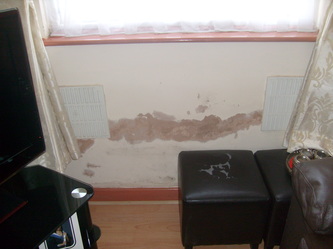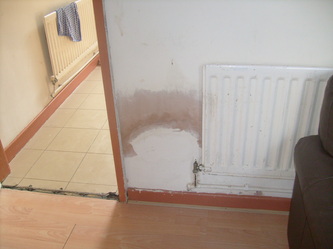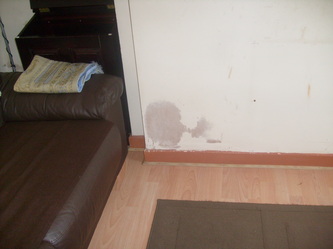What is rising damp?
Rising Damp is the term used to describe dampness in a wall structure, where there is higher moisture content at the base of the wall, which rises further up the wall. The problem of rising damp can be identified by a number of different signs, which include:
Damaged internal decoration – damp, discoloured tidemarks on internal decoration
Damaged Plaster - blistering, salting and disintegration
Rotting skirting boards, floor timbers – wet rot decay
Localized dampness – dampness on walls rarely exceeds one metre above ground level
What Causes Rising Damp?
The main causes of rising damp are:
Failure of an existing damp proof course
No damp proof course at all
High external ground bridging an existing damp proof course
Internal plaster bridging an existing damp proof course
Bridging of damp proof course due to a build up of rubble inside a cavity wall
Residual dampness at the base of the wall following a previous problem
Condensation at the base of a wall due to poor air circulation
Leaking water pipes at the base of a wall
Rising Damp Treatment
North and South Basements rising damp specialists will carry out the most appropriate treatment for your property, which will include the installation of a damp proof course. A low odour cream emulsion injection system (Wykamol Ultracure) is generally regarded as the most effective type of damp proof course. We are also using high density membranes to isolate the problems of rising damp.
Installation of damp proof course
Dependant on the thickness of walls, holes is drilled in the mortar of external and internal walls to a pre-determined depth and at the correct level and spacing between holes. These holes are then injected with damp proofing cream to reduce the movement of water through the capillaries. Following the insertion of a damp proof course it is common for re-plastering to be required. Any new plastering has to prevent dampness and salts present within the wall migrating onto the internal wall finish. The most common approach to re-plastering is using a dense sand and cement render, as a backing coat incorporating a waterproof and salt inhibiter additive. Once dry, a gypsum skim coat is applied to give a smooth finish.
When the existing plaster is removed, there may be a lot of dust. We advise that adequate steps are taken to remove or cover furnishing for protection
Cavity drain membrane
Slimline Mesh (Wykamol) is a high density polyethylene membrane incorporating 3 mm studs which allows the isolation of wet walls above and below ground. Incorporates a tough HDPE mesh lathing welded to the front face to allow the direct application of various plaster finishes or adhesive ‘dabs’ and plasterboard.
All our damp proofing solutions carry a 10 year Guarantee
Rising Damp is the term used to describe dampness in a wall structure, where there is higher moisture content at the base of the wall, which rises further up the wall. The problem of rising damp can be identified by a number of different signs, which include:
Damaged internal decoration – damp, discoloured tidemarks on internal decoration
Damaged Plaster - blistering, salting and disintegration
Rotting skirting boards, floor timbers – wet rot decay
Localized dampness – dampness on walls rarely exceeds one metre above ground level
What Causes Rising Damp?
The main causes of rising damp are:
Failure of an existing damp proof course
No damp proof course at all
High external ground bridging an existing damp proof course
Internal plaster bridging an existing damp proof course
Bridging of damp proof course due to a build up of rubble inside a cavity wall
Residual dampness at the base of the wall following a previous problem
Condensation at the base of a wall due to poor air circulation
Leaking water pipes at the base of a wall
Rising Damp Treatment
North and South Basements rising damp specialists will carry out the most appropriate treatment for your property, which will include the installation of a damp proof course. A low odour cream emulsion injection system (Wykamol Ultracure) is generally regarded as the most effective type of damp proof course. We are also using high density membranes to isolate the problems of rising damp.
Installation of damp proof course
Dependant on the thickness of walls, holes is drilled in the mortar of external and internal walls to a pre-determined depth and at the correct level and spacing between holes. These holes are then injected with damp proofing cream to reduce the movement of water through the capillaries. Following the insertion of a damp proof course it is common for re-plastering to be required. Any new plastering has to prevent dampness and salts present within the wall migrating onto the internal wall finish. The most common approach to re-plastering is using a dense sand and cement render, as a backing coat incorporating a waterproof and salt inhibiter additive. Once dry, a gypsum skim coat is applied to give a smooth finish.
When the existing plaster is removed, there may be a lot of dust. We advise that adequate steps are taken to remove or cover furnishing for protection
Cavity drain membrane
Slimline Mesh (Wykamol) is a high density polyethylene membrane incorporating 3 mm studs which allows the isolation of wet walls above and below ground. Incorporates a tough HDPE mesh lathing welded to the front face to allow the direct application of various plaster finishes or adhesive ‘dabs’ and plasterboard.
All our damp proofing solutions carry a 10 year Guarantee


